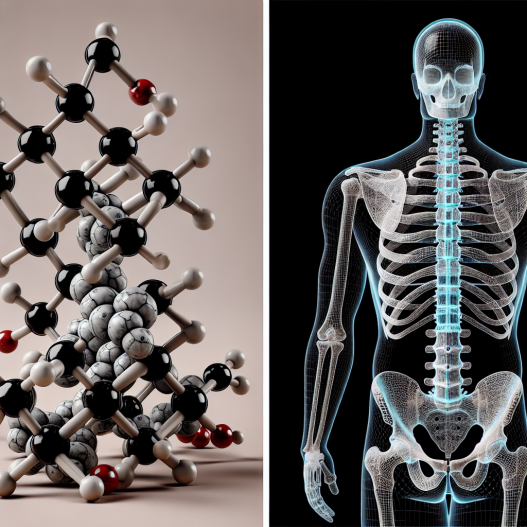-
Table of Contents
«Protect your bones with Anastrozol – the key to maintaining healthy bone density.»
Introduction
Anastrozol es un medicamento utilizado en el tratamiento del cáncer de mama en mujeres postmenopáusicas. Una de las preocupaciones comunes con este medicamento es su posible impacto en la densidad ósea de las pacientes. En esta breve introducción, discutiremos los posibles cambios en la densidad ósea asociados con el uso de Anastrozol y cómo se pueden manejar.
The Impact of Anastrozole on Bone Density in Breast Cancer Patients
Anastrozole, also known as Arimidex, is a medication commonly used in the treatment of breast cancer. It belongs to a class of drugs called aromatase inhibitors, which work by blocking the production of estrogen in the body. Estrogen is a hormone that can promote the growth of certain types of breast cancer, so by reducing its levels, anastrozole can help slow down or even stop the progression of the disease.
While anastrozole has proven to be an effective treatment for breast cancer, it is not without its side effects. One of the most concerning side effects is its impact on bone density. Studies have shown that anastrozole can lead to a decrease in bone mineral density, which can increase the risk of fractures and osteoporosis in breast cancer patients.
The link between anastrozole and changes in bone density was first discovered in clinical trials. In these trials, researchers found that women who were taking anastrozole had a higher incidence of bone fractures compared to those who were taking a placebo. This led to further investigations into the effects of anastrozole on bone health.
One study, published in the Journal of Clinical Oncology, followed 1,024 postmenopausal women with early-stage breast cancer who were taking either anastrozole or tamoxifen, another commonly used breast cancer medication. The results showed that after two years of treatment, women taking anastrozole had a 2.4% decrease in bone mineral density, while those taking tamoxifen had a 0.4% increase. This significant difference in bone density changes between the two groups highlights the potential impact of anastrozole on bone health.
So, why does anastrozole have this effect on bone density? As mentioned earlier, anastrozole works by blocking the production of estrogen. Estrogen plays a crucial role in maintaining bone health, as it helps to regulate the activity of cells responsible for bone formation and breakdown. When estrogen levels are reduced, as is the case with anastrozole, this delicate balance is disrupted, leading to a decrease in bone density.
The decrease in bone density caused by anastrozole is not limited to postmenopausal women. A study published in the Journal of Clinical Oncology looked at the effects of anastrozole on bone health in premenopausal women with early-stage breast cancer. The results showed that after two years of treatment, these women also experienced a decrease in bone mineral density, with a 2.1% decrease in the lumbar spine and a 1.7% decrease in the hip.
The impact of anastrozole on bone density is not only limited to breast cancer patients. A study published in the Journal of Bone and Mineral Research found that postmenopausal women taking anastrozole for the prevention of breast cancer also experienced a decrease in bone mineral density. This highlights the need for close monitoring of bone health in all women taking anastrozole, regardless of their breast cancer status.
So, what can be done to mitigate the effects of anastrozole on bone density? The first step is to ensure that patients are aware of this potential side effect and are regularly monitored for changes in bone density. In some cases, doctors may recommend the use of calcium and vitamin D supplements to help maintain bone health. In more severe cases, medication to prevent bone loss, such as bisphosphonates, may be prescribed.
In conclusion, anastrozole has proven to be an effective treatment for breast cancer, but it is not without its side effects. The decrease in bone density caused by anastrozole can increase the risk of fractures and osteoporosis in breast cancer patients. It is essential for patients to be aware of this potential side effect and to work closely with their healthcare team to monitor and manage their bone health while taking anastrozole.
Understanding the Mechanism of Anastrozole and Its Effects on Bone Health
Anastrozole is a medication commonly used in the treatment of breast cancer. It belongs to a class of drugs known as aromatase inhibitors, which work by blocking the production of estrogen in the body. Estrogen is a hormone that plays a crucial role in the growth and development of breast cancer cells. By inhibiting its production, anastrozole helps to slow down the progression of the disease.
While anastrozole has proven to be an effective treatment for breast cancer, it has also been associated with certain side effects, one of which is changes in bone density. This has raised concerns among patients and healthcare professionals alike, as bone health is essential for overall well-being and quality of life. In this article, we will delve into the mechanism of anastrozole and its effects on bone health.
To understand how anastrozole affects bone density, it is important to first understand the role of estrogen in bone health. Estrogen plays a crucial role in maintaining bone density by regulating the activity of osteoblasts and osteoclasts, the cells responsible for bone formation and resorption, respectively. When estrogen levels decrease, as is the case with anastrozole treatment, the balance between these two types of cells is disrupted, leading to a decrease in bone density.
Studies have shown that anastrozole can cause a decrease in bone mineral density (BMD) in postmenopausal women. This is because postmenopausal women already have lower levels of estrogen, and anastrozole further decreases it. As a result, they are at a higher risk of developing osteoporosis, a condition characterized by weak and brittle bones. Osteoporosis increases the risk of fractures, which can significantly impact a person’s quality of life.
However, it is important to note that not all women who take anastrozole will experience a decrease in BMD. Factors such as age, body mass index, and previous history of fractures can also play a role in determining the impact of anastrozole on bone health. Additionally, lifestyle factors such as diet and exercise can also influence bone density.
To mitigate the effects of anastrozole on bone health, healthcare professionals may recommend lifestyle modifications and prescribe medications to prevent bone loss. These may include calcium and vitamin D supplements, as well as bisphosphonates, which are drugs that help to slow down bone loss. Regular exercise, particularly weight-bearing exercises, can also help to maintain bone density.
It is also important to note that the decrease in BMD caused by anastrozole is not permanent. Once treatment with anastrozole is stopped, estrogen levels will gradually return to normal, and bone density will improve. However, it is crucial to monitor bone health during and after treatment to ensure that any changes are addressed promptly.
In addition to its effects on bone density, anastrozole has also been associated with joint pain and stiffness. This is because estrogen also plays a role in maintaining joint health by regulating the production of collagen, a protein that provides structure and support to joints. When estrogen levels decrease, joint pain and stiffness can occur. However, these symptoms are usually temporary and can be managed with over-the-counter pain relievers and physical therapy.
In conclusion, anastrozole is a medication that has proven to be effective in the treatment of breast cancer. However, it is important to be aware of its potential effects on bone health. By understanding the mechanism of anastrozole and its impact on bone density, patients and healthcare professionals can work together to mitigate any potential risks and ensure overall well-being during and after treatment. Regular monitoring and lifestyle modifications can help to maintain bone health and prevent any long-term consequences.
Managing Bone Loss in Breast Cancer Patients Taking Anastrozole: Strategies and Considerations
Anastrozole is a commonly prescribed medication for the treatment of breast cancer. It belongs to a class of drugs known as aromatase inhibitors, which work by blocking the production of estrogen in the body. Estrogen is a hormone that can promote the growth of certain types of breast cancer cells. By reducing estrogen levels, anastrozole helps to slow down or stop the growth of breast cancer cells.
While anastrozole has been proven to be effective in treating breast cancer, it can also have some side effects. One of the most concerning side effects is its impact on bone health. Studies have shown that anastrozole can lead to a decrease in bone density, which can increase the risk of fractures and osteoporosis. This is a significant concern for breast cancer patients, as they are already at a higher risk for bone loss due to the effects of chemotherapy and hormonal therapy.
So, what can be done to manage bone loss in breast cancer patients taking anastrozole? The first step is to understand the potential risks and take proactive measures to prevent or minimize them. It is essential for patients to have regular bone density screenings to monitor any changes in their bone health. This will allow healthcare providers to intervene early if necessary and prevent further bone loss.
In addition to regular screenings, there are several strategies that can be implemented to manage bone loss in breast cancer patients taking anastrozole. One of the most effective ways is through lifestyle modifications. This includes incorporating weight-bearing exercises into daily routines, such as walking, jogging, or weightlifting. These activities help to strengthen bones and improve bone density. It is also important for patients to maintain a healthy diet rich in calcium and vitamin D, as these nutrients are essential for bone health.
In some cases, lifestyle modifications may not be enough to prevent bone loss. In these situations, medication may be prescribed to help manage bone density. Bisphosphonates, a class of drugs commonly used to treat osteoporosis, have been shown to be effective in preventing bone loss in breast cancer patients taking anastrozole. These medications work by slowing down the breakdown of bone tissue, allowing for new bone to be formed.
Another consideration for managing bone loss in breast cancer patients taking anastrozole is the duration of treatment. Studies have shown that the longer a patient takes anastrozole, the greater the risk of bone loss. Therefore, it is essential for healthcare providers to regularly reassess the need for continued treatment with anastrozole. In some cases, switching to a different medication or taking breaks from treatment may be necessary to prevent further bone loss.
It is also important for healthcare providers to consider the individual patient’s risk factors for bone loss when prescribing anastrozole. Factors such as age, menopausal status, and previous history of bone fractures should be taken into account. Patients with a higher risk of bone loss may benefit from additional interventions, such as calcium and vitamin D supplements or hormone replacement therapy.
In conclusion, managing bone loss in breast cancer patients taking anastrozole requires a proactive and individualized approach. Regular bone density screenings, lifestyle modifications, and medication can all play a role in preventing or minimizing bone loss. It is crucial for healthcare providers to closely monitor patients and adjust treatment plans as needed to ensure the best possible outcomes. By taking these strategies and considerations into account, breast cancer patients can continue to receive the benefits of anastrozole while also protecting their bone health.
Q&A
1) ¿Puede el uso de Anastrozol afectar la densidad ósea?
Sí, el Anastrozol puede afectar la densidad ósea en algunas personas. Este medicamento se usa para tratar el cáncer de mama en mujeres posmenopáusicas y puede disminuir la cantidad de estrógeno en el cuerpo, lo que puede llevar a una pérdida de densidad ósea.
2) ¿Cómo se monitorea la densidad ósea en pacientes que toman Anastrozol?
Los pacientes que toman Anastrozol deben someterse a pruebas de densidad ósea periódicas para monitorear cualquier cambio en la densidad ósea. Esto puede incluir una densitometría ósea o una prueba de absorciometría de rayos X de energía dual (DEXA).
3) ¿Existen medidas preventivas para proteger la densidad ósea mientras se toma Anastrozol?
Sí, hay medidas preventivas que pueden ayudar a proteger la densidad ósea mientras se toma Anastrozol. Estas pueden incluir una dieta rica en calcio y vitamina D, ejercicio regular y evitar fumar y beber en exceso. También es importante seguir las recomendaciones del médico y tomar cualquier suplemento de calcio o vitamina D recetado.









